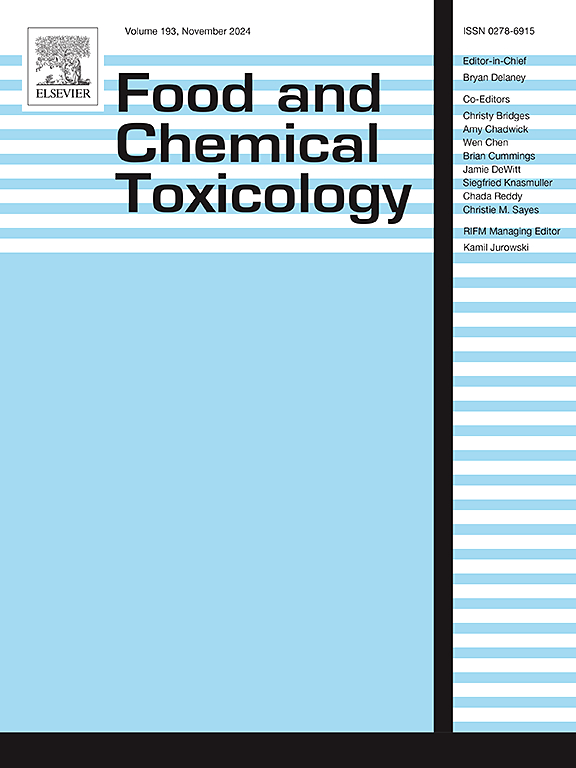Atractylenolide III ameliorates DSS-induced colitis by improving intestinal epithelial barrier via suppressing the NF-κB-Mediated MLCK-pMLC signaling pathway
IF 3.9
3区 医学
Q2 FOOD SCIENCE & TECHNOLOGY
引用次数: 0
Abstract
This study is to demonstrate the protection of atractylenolide III (AT III) on intestinal barrier dysfunction in ulcerative colitis (UC). UC model was established by 3% dextran sulfate sodium (DSS), and TNF-α was used to induce dysfunction in the intestinal epithelial barrier. TEER, FD-4 transmembrane flux and DAI were measured. Histopathological changes was identified by H&E staining, TJ structure changes were observed by TEM, IL-1β and TNF-α contents were measured by ELISA, bacterial translocation was investigated by FISH. The expressions of ZO-1, occludin, and the proteins in the MLCK/p-MLC and NF-κB pathways were analyzed by Western blotting or immunofluorescence. The results indicated that AT III alleviate the symptoms of DSS-induced colitis, reduce the disruption of intestinal epithelial barrier, and decrease FD4. Moreover, AT III inhibited the destruction of intestinal epithelial TJ structure and bacterial translocation in UC mice. AT III reversed the high levels of IL-1β and TNF-α, the decrease of occludin, ZO-1 expressions. Furthermore, AT III showed similar effects to PDTC (pyrrolidinedithiocarbamate) in ameliorating the disruption of the TNF-α-induced TEER and FD-4 disruption, MLCK protein expression, and MLC2 phosphorylation. In conclusion, AT III mitigates the dysfunction of intestinal epithelial barrier in UC through the NF-κB-mediated MLCK/p-MLC signaling pathway.

苍术内酯III通过抑制NF-κ b介导的MLCK-pMLC信号通路改善肠上皮屏障,改善dss诱导的结肠炎。
本研究旨在证明白术内酯III (atiii)对溃疡性结肠炎(UC)患者肠道屏障功能障碍的保护作用。用3%葡聚糖硫酸钠(DSS)建立UC模型,用TNF-α诱导肠上皮屏障功能障碍。测定TEER、FD-4跨膜通量和DAI。H&E染色观察组织病理变化,TEM观察TJ结构变化,ELISA检测IL-1β和TNF-α含量,FISH观察细菌易位。Western blotting或免疫荧光法检测ZO-1、occludin及MLCK/p-MLC、NF-κB通路蛋白的表达。结果表明,AT III可减轻dss诱导结肠炎的症状,减轻肠上皮屏障的破坏,降低FD4。此外,AT III抑制UC小鼠肠上皮TJ结构的破坏和细菌易位。AT III逆转高水平IL-1β、TNF-α, occludin、ZO-1表达降低。此外,AT III在改善TNF-α-诱导的TEER和FD-4破坏、MLCK蛋白表达和MLC2磷酸化方面表现出与PDTC(吡罗烷二硫代氨基甲酸酯)相似的效果。综上所述,AT III通过NF-κ b介导的MLCK/p-MLC信号通路减轻UC肠上皮屏障功能障碍。
本文章由计算机程序翻译,如有差异,请以英文原文为准。
求助全文
约1分钟内获得全文
求助全文
来源期刊

Food and Chemical Toxicology
工程技术-毒理学
CiteScore
10.90
自引率
4.70%
发文量
651
审稿时长
31 days
期刊介绍:
Food and Chemical Toxicology (FCT), an internationally renowned journal, that publishes original research articles and reviews on toxic effects, in animals and humans, of natural or synthetic chemicals occurring in the human environment with particular emphasis on food, drugs, and chemicals, including agricultural and industrial safety, and consumer product safety. Areas such as safety evaluation of novel foods and ingredients, biotechnologically-derived products, and nanomaterials are included in the scope of the journal. FCT also encourages submission of papers on inter-relationships between nutrition and toxicology and on in vitro techniques, particularly those fostering the 3 Rs.
The principal aim of the journal is to publish high impact, scholarly work and to serve as a multidisciplinary forum for research in toxicology. Papers submitted will be judged on the basis of scientific originality and contribution to the field, quality and subject matter. Studies should address at least one of the following:
-Adverse physiological/biochemical, or pathological changes induced by specific defined substances
-New techniques for assessing potential toxicity, including molecular biology
-Mechanisms underlying toxic phenomena
-Toxicological examinations of specific chemicals or consumer products, both those showing adverse effects and those demonstrating safety, that meet current standards of scientific acceptability.
Authors must clearly and briefly identify what novel toxic effect (s) or toxic mechanism (s) of the chemical are being reported and what their significance is in the abstract. Furthermore, sufficient doses should be included in order to provide information on NOAEL/LOAEL values.
 求助内容:
求助内容: 应助结果提醒方式:
应助结果提醒方式:


